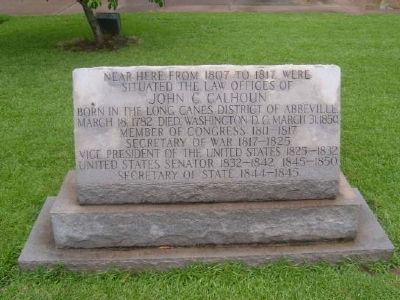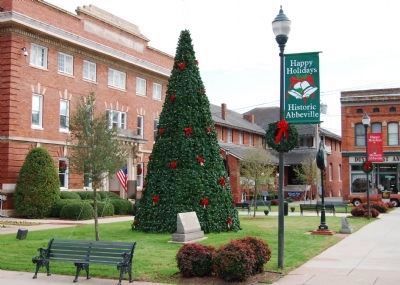Abbeville in Abbeville County, South Carolina — The American South (South Atlantic)
The Law Offices of John C. Calhoun
situated the law offices of
John C. Calhoun.
Born in the Long Canes District of Abbeville March 18, 1782.
Died, Washington D.C.
March 31, 1850.
Member of Congress
1811-1817
Secretary of War
1817-1825
Vice President of the United States
1825-1832
United States Senator
1832-1842, 1845-1850
Secretary of State
1844-1845
Topics. This historical marker is listed in this topic list: Government & Politics. A significant historical date for this entry is March 18, 1896.
Location. 34° 10.656′ N, 82° 22.72′ W. Marker is in Abbeville, South Carolina, in Abbeville County. Marker is on County Square. Marker is located on the green between the Abbeville County Courthouse and the Opera House. It marks the location of an old street named Law Row where several local attornies kept offices. Touch for map. Marker is in this post office area: Abbeville SC 29620, United States of America. Touch for directions.
Other nearby markers. At least 10 other markers are within walking distance of this marker. "Big Bob" (a few steps from this marker); Abbeville Square (a few steps from this marker); Abbeville County Confederate Monument (a few steps from this marker); Major Thomas Dry Howie (within shouting distance of this marker); Abbeville County Courthouse (1908) (within shouting distance of this marker); The Lynching of Anthony Crawford / Racial Violence in South Carolina (within shouting distance of this marker); Abbeville Opera House (1908) (within shouting distance of this marker); Humane Society Alliance Fountain (1912) (within shouting distance of this marker); Old Bank Building (ca. 1865) (within shouting distance of this marker); Belmont Inn (1903) (within shouting distance of this marker). Touch for a list and map of all markers in Abbeville.
Also see . . .
1. John C. Calhoun. John Caldwell Calhoun (March 18, 1782 – March 31, 1850) was a leading United States Southern politician from South Carolina during the first half of the 19th century. (Submitted on November 15, 2008, by Brian Scott of Anderson, South Carolina.)
2. John C. Calhoun in the U.S. Capital. In the struggles for power leading up to the Civil War one name that was heard again and again was that of John C. Calhoun of South Carolina. (Submitted on November 15, 2008, by Brian Scott of Anderson, South Carolina.)
3. "The Clay Compromises", a speech by John C. Calhoun, March 4, 1850. This is among John C. Calhoun's most famous speeches. He was too ill to deliver it himself, so it was read by another senator with Calhoun present in the Senate Chamber. Calhoun, so ill he had to be helped out of the Chamber after the speech by two of his friends, died on March 31, 1850. (Submitted on December 27, 2008, by Brian Scott of Anderson, South Carolina.)
Additional commentary.
1. Account of Calhoun’s Early Life
He left Charleston about the 1st of June, 1807, and returned to Abbeville village, where he expected to established himself as a lawyer…Immediately after the attack on the Chesapeake, June 22, 1807, the farmers of Abbeville district called a public meeting…the committee of arrangements selected him to draw up and present the resolutions to the citizens of Abbeville.
For the first time in his life he rose to his feet before his assembled countrymen. Standing 1 or 2 inches above 6 feet, the giant, erect, young man, then in the 26th year of his age, presented the marked visage known to many in the audience, and for the first time flashed upon them the intense light from those dark brown eyes. No report has reached us of this important speech except through tradition.
That it was effective we know from the results
which followed. The people of Abbeville district had long entertained an objection to being represented in the legislature by lawyers. For many years no one of that profession had ventured to offer himself as a candidate for political honors. Now, however, with general acclaim, the people of his native district called for John Caldwell Calhoun and elected him to the legislature at the head of the ticket. (Source: Annual Report of the American Historical Association, 1899, page 85.)
— Submitted September 12, 2008, by Brian Scott of Anderson, South Carolina.
2. John C. Calhoun (1782-1850)
Calhoun, John Caldwell, (cousin of John Ewing Colhoun and Joseph Calhoun), a Representative and a Senator from South Carolina and a Vice President of the United States; born near Calhoun Mills, Abbeville District (now Mount Carmel, McCormick County), S.C., March 18, 1782; attended the common schools and private academies; graduated from Yale College in 1804; studied law, admitted to the bar in 1807, and commenced practice in Abbeville, S.C.; also engaged in agricultural pursuits; member, State house of representatives 1808-1809; elected as a Democratic Republican to the Twelfth and to the three succeeding Congresses and served from March 4, 1811, to November 3, 1817, when he resigned;
Secretary of War in the Cabinet of President James Monroe 1817-1825; elected vice president of the United States in 1824 with President John Quincy Adams; reelected in 1828 with President Andrew Jackson and served from March 4, 1825, to December 28, 1832, when he resigned, having been elected as a Democratic Republican (later Nullifier) to the United States Senate on December 12, 1832, to fill the vacancy caused by the resignation of Robert Y. Hayne; reelected in 1834 and 1840 and served from December 29, 1832, until his resignation, effective March 3, 1843; Secretary of State in the Cabinet of President John Tyler 1844-1845; again elected to the United States Senate, as a Democrat, to fill the vacancy caused by the resignation of Daniel E. Huger; reelected in 1846 and served from November 26, 1845, until his death in Washington, D.C., March 31, 1850; chairman, Committee on Finance (Twenty-ninth Congress); interment in St. Philip’s Churchyard, Charleston, S.C. (Source: Biographical Directory of the U.S. Congress.)
— Submitted November 20, 2009, by Brian Scott of Anderson, South Carolina.
3. About John C. Calhoun
For over 30 years, this son of South Carolina made sure his voice was heard in Washington. Calhoun held high-level positions in several administrations.
He
was born near Calhoun Mills, Abbeville District (now Mount Carmel, McCormick County), S.C., March 18, 1782. He graduated from Yale College in 1804, studied law and was admitted to the bar in 1807. He set up a practice in Abbeville, S.C.
His political life began in 1808 when he was elected as a member of the State House of Representatives (1808-1809). He was elected as a Democratic Republican to the 12th Congress on March 4, 1811. He remained a member until November 3, 1817, when he resigned, accepting the position of Secretary of War under President James Monroe (1817-1825). Calhoun was elected vice president of the United States in 1824 under President John Quincy Adams and in 1828 under President Andrew Jackson. He served under Jackson until December 28, 1832, when he resigned (making Calhoun the only vice president to ever resign).
Calhoun was then elected as a Democratic Republican (later Nullifier) to the United States Senate on December 12, 1832, to fill the vacancy caused by the resignation of Robert Y. Hayne. He was reelected in 1834 and 1840 and served from December 29, 1832, until his resignation, on March 3, 1843, at which time he accepted the position of Secretary of State under President John Tyler (1844-1845). He was again elected to the United States Senate, this time as a Democrat, to fill the vacancy caused by the resignation of Daniel E. Huger.
He was reelected in 1846 and served from November 26, 1845, until his death in Washington, D.C., March 31, 1850.
Once he was elected to federal office, Calhoun moved from Abbeville and took up residency in Fort Hill, now on the Clemson University campus. It was here that he lived with his wife (and cousin) Floride Colhoun and three children: Cornelia, John, and Anna Maria. Anna Marie later married a wealthy planter named Thomas Green Clemson, the namesake and founder of Clemson University.
John C. Calhoun is buried in St. Philip’s Churchyard, Charleston, S.C. In 1957, a U.S. Senate committee chaired by Senator John F. Kennedy, named the Five Greatest Senators in U.S. History. The list in order was:
1) Henry Clay (KY)
2) John C. Calhoun (SC)
3) Daniel Webster (MA)
4) Robert Taft (OH)
5) Robert La Follette, Sr. (WI)
In 2004, the Senate added Arthur Vandenberg (MI) and Robert Wagner (NY) to the list.
— Submitted December 27, 2008, by Brian Scott of Anderson, South Carolina.
4. The Calhoun Prophecy
As he was nearing his end of his life, Calhoun penned these words: "The Union is doomed to dissolution; there is no mistaking the signs...I fix its probable occurance within a range of twelve years...You and others of your age will probably live to see it; I shall not. The mode by which it will be is not so clear...but the probability is it will explode in a Presidential election." Calhoun died March 31, 1850. Shots were fired Charleston Harbor on April 12, 1861. Calhoun missed the date by less than two weeks.
— Submitted September 14, 2008, by Brian Scott of Anderson, South Carolina.
Credits. This page was last revised on August 11, 2023. It was originally submitted on April 26, 2008, by Brian Scott of Anderson, South Carolina. This page has been viewed 6,933 times since then and 70 times this year. Photos: 1. submitted on April 26, 2008, by Brian Scott of Anderson, South Carolina. 2. submitted on November 15, 2008, by Brian Scott of Anderson, South Carolina. 3. submitted on December 27, 2008, by Brian Scott of Anderson, South Carolina. 4. submitted on July 20, 2009, by Brian Scott of Anderson, South Carolina. 5. submitted on November 10, 2009, by Brian Scott of Anderson, South Carolina. 6. submitted on July 20, 2009, by Brian Scott of Anderson, South Carolina. • Craig Swain was the editor who published this page.





